Products / Purification Kits / SciPhiTM Gel Extraction Kit
SciPhiTM Gel Extraction Kit
SciPhiTM Gel Extraction Kit
Catalog Number
- NXG994-L : 250 Preps
- NXG994-M : 50 Preps
- NXG994-S : 10 Preps
- NXG994-XS : 05 Preps
Product Description
- Compatibility: SciPhiTM gel extraction kit is designed for fast and efficient purification of DNA fragments from standard and low-melting agarose gels.
- Silica Membrane Spin Column Technology: The kit is based on silica membrane spin column technology for efficient purification of DNA fragments from agarose gels.
- SciPhiTM Purification Columns: Preassembled with collection tubes. Broad Range: Purify DNA fragments of 25 bp to 20 kb.
- Maximum Recovery: High recovery rates of up to 95% for DNA 100 bp to 10 kb.
- Binding Capacity: Binding capacity of up to 25 μg of DNA for efficient processing of up to 1 gram of agarose gel.
- Fast Protocol: Complete the entire process in just 15 minutes, saving valuable time.
- Downstream Applications: The purified DNA is immediately ready for use in various downstream applications, including PCR, restriction digestion, ligation, sequencing, hybridization and labeling.
Send EnquirySend Feedback
Storage Instructions:
SciPhiTM Gel Extraction kit can be stored at room temperature (15 to 25°C). However, the columns can be stored at 4°C in case of storage periods is more than 1 year, Please remember to properly close the bag containing SciPhiTM Genomic DNA Purification Columns after each usage.
Principle:
- Excision: The DNA fragment of interest is first visualized on an agarose gel is carefully cut out from the gel using a clean, sharp tool, like a razor blade or a specialized gel extraction tool.
- Solubilization: The gel slice is then solubilized in a binding buffer containing a chaotropic agent. Chaotropic agents disrupt hydrogen bonding, thereby denaturing proteins and dissolving the agarose gel.
- DNA Binding: The binding buffer used for solubilization promotes binding of DNA to silica membrane of the column, while other impurities, such as proteins, nucleotides, and unincorporated primers, do not efficiently bind and remain in the solution.
- pH Indicator: The binding buffer is often designed with a colour indicator that changes colour with pH. This pH indicator allows easy monitoring of the solution’s pH, ensuring that the optimal conditions for DNA binding to the silica are maintained.
- Washing: After the DNA binds to the silica, the impurities are washed away from the column using a series of wash steps. These wash steps help to remove any remaining contaminants that might interfere with downstream applications.
- Elution: Finally, the purified DNA is eluted from the silica column using an elution buffer, typically with a lower pH than the binding buffer. This elution process helps to release the DNA from the silica and make it available in a clean, concentrated form for downstream applications.

